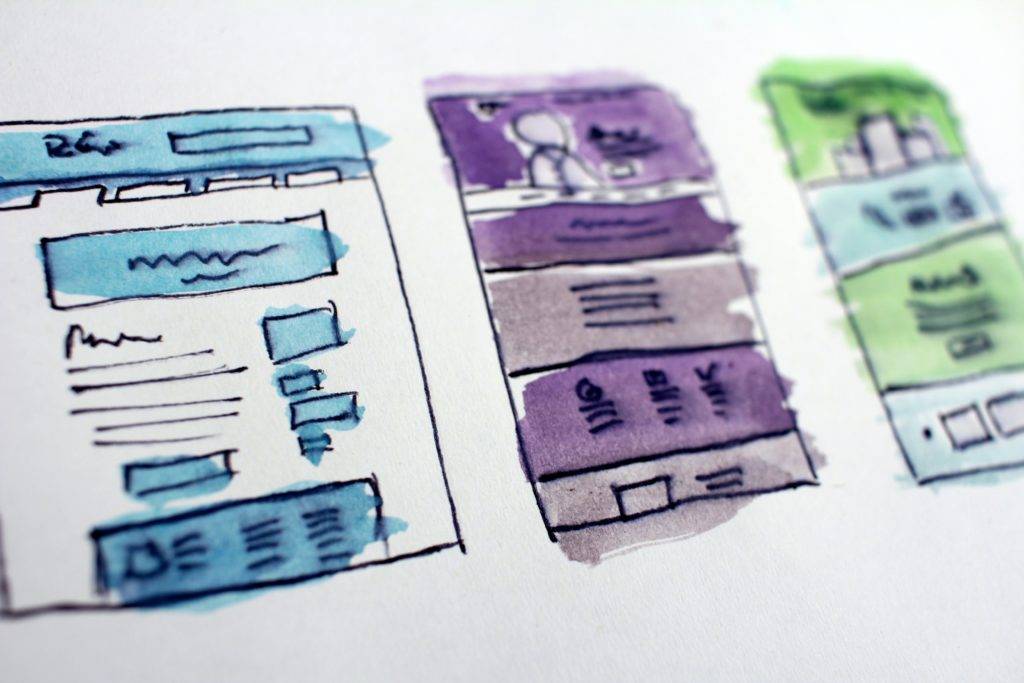It’s an agony every salesperson knows only too well: you’re on a call with a potential client, and they’ve opened the door for you to make your sales pitch, and it falls a little flat. Your examples aren’t quite resonating, and you’re scrambling for key data to illustrate your point and show how your product or service can alleviate the pain points your prospect is describing.
Enter sales enablement collateral. If you had a fully loaded playbook or sales enablement software, these key pieces of information would be right at your fingertips, helping you close the deal then and there; no follow-up needed!
So, how do sales teams create and unleash the power of sales enablement collateral? These tips will have you developing and implementing the right types of content to help your sales teams close more deals and shorten your sales cycle.
What is sales enablement collateral?
Sales enablement collateral refers to a collection of resources specifically designed to assist in the sales process. These materials empower sales representatives by providing the necessary tools, information, and content to engage leads, overcome objections, and facilitate the buyer's journey.
Sales enablement content serves a dual purpose:
For the sales team:
It offers a structured, consistent set of resources to lean on during the sales process, ensuring representatives can effectively handle objections, answer questions, and showcase value. Companies with sales enablement strategies experience an 8% increase in their quarterly revenue, underscoring the significant economic impact of sales enablement
For the prospect:
From the potential customer's perspective, this collateral offers deeper insights, testimonials, and evidence about the product or service, helping to build trust, clarify doubts, and encourage a purchase decision.
Examples of sales enablement collateral include product datasheets, battle cards, case studies, testimonials, product demo videos, pricing guides, FAQ sheets, and much more.
The idea is to anticipate potential customers' questions and concerns and equip your sales team with ready-to-share materials addressing those points and smoothing the path to purchase.
Who is responsible for sales enablement collateral?
A common misconception is that the creation and management of sales enablement collateral fall solely on the sales department. In reality, it’s a collaborative effort, leaning on the strengths of multiple teams within an organization. Here's a breakdown of the key players and their respective roles:
Sales team:
They're on the frontline, interacting with potential customers. As such, they have invaluable firsthand knowledge of the questions, objections, and concerns that commonly arise during sales.
Their responsibility lies in identifying gaps in current collateral, offering feedback on what works (and what doesn’t), and suggesting new materials that could be beneficial.
Marketing team:
Marketers understand the buyer's persona, market trends, and how to create marketing collateral and compelling, effective sales collateral. Taking insights from the sales team, they transform them into well-designed, engaging, and informative collateral pieces.
This includes crafting on brand case studies, designing product sheets, producing demo videos, landing pages, and more.
Product or service teams:
These experts understand the intricacies of the product or service being sold. They offer technical details, benefits, and unique selling propositions that can be incorporated into the collateral. They can also assist in creating training materials or demos.
Training & development teams:
Experts in internal training and skill development, they ensure the sales team knows how to use the types of sales collateral provided effectively. This can involve training sessions, role-playing exercises, or even creating a resource hub where sales reps can access the latest materials.
Customer success & support teams:
They interact with customers post-purchase and understand common challenges, successes, and feedback. They share insights about customer testimonials, case studies, or FAQs that can then be developed into sales enablement collateral.
As you can see, creating effective sales enablement is truly a team effort. A proposal tool like Qwilr ensures that the sales team is equipped, at all times, with content that is relevant, up-to-date, and resonant with the target audience's needs and concerns. Not to mention easy to edit on the fly when necessary.
Crafting a strong sales enablement collateral strategy
Establishing a compelling sales enablement collateral strategy doesn't happen overnight. It requires thoughtful planning, continuous refinement, and interdepartmental collaboration. In short, the left hand needs to know what the right hand is doing! Here's a step-by-step guide to ensure you’re on the right track:
1. Understand your buyer’s journey
Map out the stages your prospects go through, from awareness to consideration, decision, and post-purchase. Think about what problems they’re trying to solve, what questions they might be asking, and who else they might compare you to at each step in their process. This helps identify what kind of collateral is needed at each stage to guide the prospect seamlessly.
2. Gather insights from sales & customer support
Regularly schedule meetings or feedback sessions with these teams. They offer frontline insights into common questions, objections, and concerns. Addressing these in your collateral can dramatically increase its effectiveness.
3. Define clear objectives
Set clear, measurable objectives for each piece of collateral. Is it lead conversion? Addressing a common objection? Or onboarding new clients? Be specific to ensure every piece of content has a clear purpose. This will also help ensure measuring its effectiveness is more straightforward.
4. Collaborate on content creation
Involve product teams, marketers, and other stakeholders in content creation. Different perspectives lead to comprehensive and compelling collateral that caters to the prospect's concerns from every angle.
5. Make it easily accessible
Use tools or platforms where the sales team can quickly find and share the collateral they need. This could be a type content management software or some other sales enablement tools that embed content right where sellers need it, even within the CRM. Speed and accessibility are crucial. Sales reps shouldn’t waste time searching for materials during critical moments.
6. Keep content updated
Review and update your collateral regularly. Market dynamics, product features, and customer needs evolve – and so should your sales materials. Outdated information can be more harmful than having no information, with the potential to mislead prospective customers and erode the trust you’ve worked so hard to build up.
7. Measure and refine
Use analytics to gauge the effectiveness of your collateral. Monitor metrics like engagement rate, conversion rate, and feedback from the sales team. Continuous refinement based on real-world data ensures your collateral remains relevant and effective and enhances decision making when it comes to adding new content or delivery methods.
8. Educate the sales team
Of course, the best collateral in the world does you no good if you don’t know how to use it! Organize training sessions, workshops, or webinars to ensure your sales team knows how to utilize these assets best.
Incorporating these steps into your strategy ensures you're not just creating collateral but building valuable tools and sales playbooks that genuinely empower your sales team, allowing them to focus on what they do best: building relationships and closing deals.
Core sales enablement assets every team needs
Understanding where your potential customer is in the different stages of the sales cycle is crucial to your sales strategy. Offering the right content at the right time can be the deciding factor in moving them down your sales funnel or having them drop out entirely. Let’s break down the different examples of sales collateral aligned with key stages of the sales cycle:
Prospecting
You're trying to grab the attention of potential clients and make them aware of your product or service.
- Cold Outreach Templates: Standardized yet customizable email templates or message templates for initial outreach. (Qwilr’s AI Page Builder can save you a heap of time here!)
- Educational Content: Content marketing such as blog posts, infographics, and short videos that offer valuable insights related to your industry or the problems your product/service addresses.
- Social Proof Assets: Short client testimonials or industry recognition badges to build initial trust in this awareness stage.
Discovery
This is when potential clients show interest, and you're learning more about their specific needs and challenges.
- Needs Assessment Forms: Structured forms or questionnaires to understand the prospect’s pain points, requirements, and goals.
- Product/Service Overview: A concise, visually engaging overview highlighting key features and benefits.
- Case Studies: Real-world examples of how your product/service helped similar businesses or industries.
Consideration
At the consideration stage, prospects are now weighing up their options, comparing you to competitors, and looking for the deeper information that will move them onto the decision stage.
- Comparison Sheets: Clearly present how your product/service stands out from competitors.
- Deep Dive Product Materials: Detailed product guides, technical specifications, or whitepapers for those wanting an in-depth look.
- Webinars and Demos: Interactive sessions where prospects can see your product in action and ask questions.
- Sales Presentations and Proposals: The sales proposal acts as a reference point for both buyer and seller, and the beginning of the negotiation process. Companies as diverse as Deloitte and Dropbox have found our proposal templates and template gallery give them impressive and business-winning- collateral in a fraction of the time.
Decision
So, your decision-makers are on the brink of making their choice. Now, they need reassurance and clarity.
- Pricing Guides: Transparent breakdowns of pricing, including any packages, discounts, or add-ons.
- Testimonials and Reviews: Detailed success stories or client feedback showcasing the value you’ve provided.
- Implementation and Onboarding Buyer’s Guides: Outlining the steps after purchase, ensuring a smooth transition.
Retention and expansion
And after the sale, the journey isn’t over. You want to nurture the relationship and possibly upsell or cross-sell.
- User Manuals and Tutorials: Ensuring clients can make the most of what they've purchased.
- Feedback Forms: Regularly collecting feedback to improve and potentially identify new areas where you can assist.
- Loyalty Programs or Upsell Opportunities: Special offers, advanced features, or complementary services or products customers might be interested in.
By tailoring your sales enablement assets to each stage of the sales cycle, you provide your team with powerful tools to engage, educate, and nurture potential clients, increasing the likelihood of successful conversions and long-term relationships.
30-day plan: elevating your sales enablement collateral
Revitalizing your sales enablement collateral can be the shot in the arm that transforms your sales process, making your team more efficient and resonating better with your prospects. Here’s a strategic 30-day plan to elevate your materials:
Week 1: Assessment and feedback gathering
Day 1-3:
Activity: Audit your existing collateral.
Objective: Identify outdated materials, gaps, and areas of improvement.
Day 4-5:
Activity: Meet with sales and customer support teams.
Objective: Gather feedback on what's working, what's missing, and what challenges they're currently facing.
Day 6-7:
Activity: Analyze competitor collateral.
Objective: Understand industry standards and identify unique opportunities to stand out.
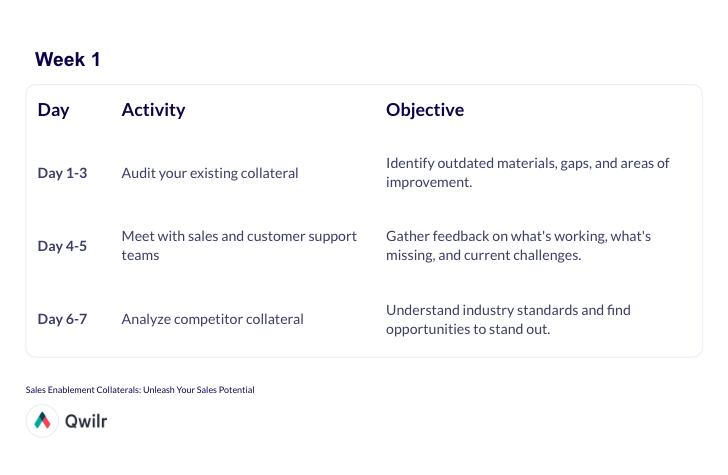
Week 2: Content creation and refinement
Day 8-10:
Activity: Prioritize collateral updates and new content creation based on feedback.
Objective: Ensure the most impactful pieces are addressed first.
Day 11-14:
Activity: Collaborate with the marketing and product teams.
Objective: Start the redesign and content creation process. Begin with high-priority assets.
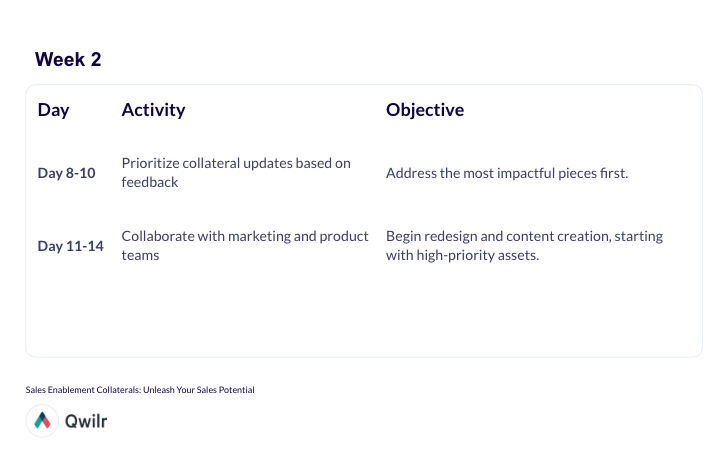
Week 3: Implementation and accessibility
Day 15-17:
Activity: Update your sales enablement platform or repository.
Objective: Ensure new and updated collateral is easily accessible to the sales team.
Day 18-20:
Activity: Organize training sessions.
Objective: Ensure the sales team understands how to utilize the new collateral effectively.
Day 21:
Activity: Seek initial feedback.
Objective: After initial use, gather feedback from the sales team on the new materials.
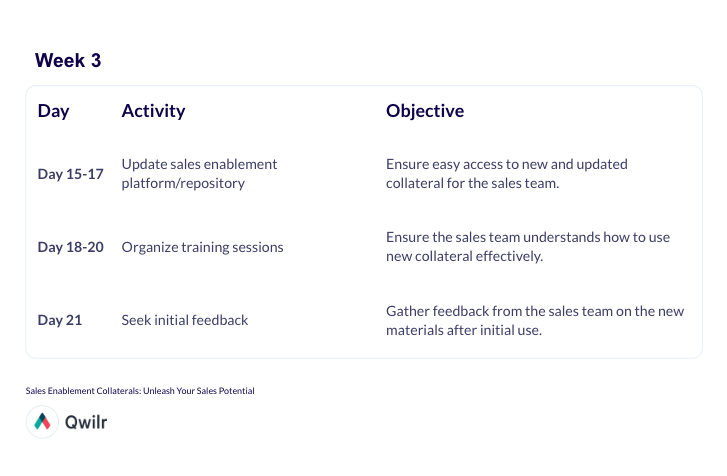
Week 4: Review, measure, and continuously improve
Day 22-24:
Activity: Refinement based on feedback.
Objective: Make any necessary tweaks to the collateral.
Day 25-28:
Activity: Analyze engagement and usage metrics.
Objective: Understand which pieces of collateral are being used most and their impact on the sales process.
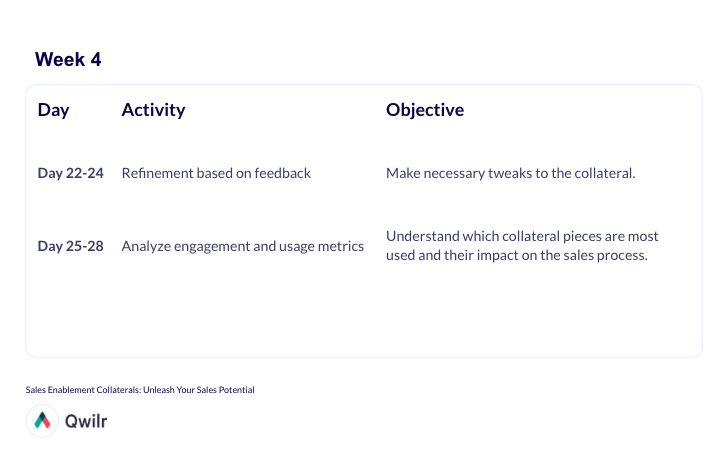
Week 5: Wrap up, celebrate accomplishments, and plan for the next iteration
Day 29:
Activity: Host a feedback session with the sales team.
Objective: Dive deeper into qualitative insights about the collateral's effectiveness.
Day 30:
Activity: Celebrate and acknowledge the collaboration and plan for the next iteration.
Objective: Use gathered insights to map out the next phase of improvements. Recognize the efforts of all teams involved and reinforce the importance of continuous improvement.
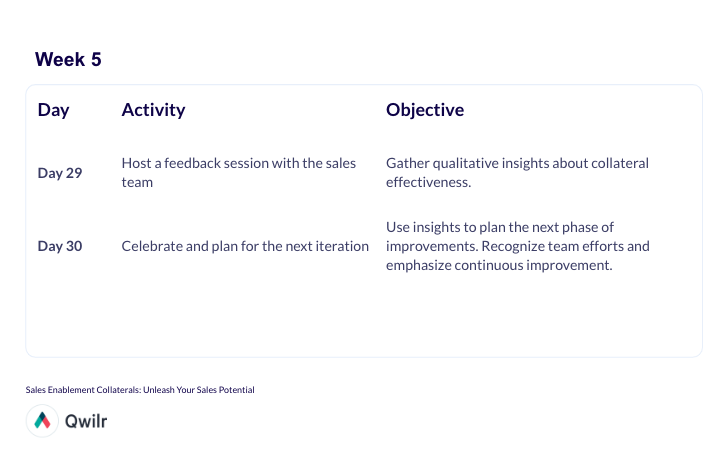
By following this structured 30-day plan, you’ll not only refresh and revitalize your sales enablement collateral, but also instill a culture of continuous feedback and improvement, ensuring that your materials remain effective, relevant, and aligned with both your sales team's and prospects' needs.
FAQs
What is the main purpose of sales enablement collateral?
Sales enablement collateral is a toolkit for sales reps, providing them with the necessary materials and content to effectively engage prospects and customers throughout the sales cycle. The primary purpose is to enhance sales conversations, address common questions and objections, and, ultimately, drive conversions.
How often should sales enablement collateral be updated?
It's essential to review and update sales enablement collateral regularly. There's no one-size-fits-all answer, but a good rule of thumb is to conduct a thorough review every quarter. However, if there are significant changes in products, services, market dynamics, or buyer personas, immediate updates might be necessary.
How can I measure the effectiveness of my sales enablement collateral?
Effectiveness can be measured through various metrics, including engagement rates with the collateral (like click-through rates for digital assets), feedback from sales reps, and conversion rates in stages where the collateral is heavily used. Regular feedback sessions with the sales team can also provide qualitative insights into what's working and what's not.
What are common sales enablement best practices?
Sales enablement best practices are:
- Tailoring content to align with every stage of the buyer journey
- Ensuring reps can easily access and share the information
- Training to ensure sales reps can use the collateral most effectively
- Using feedback from reps and customers to refine the collateral
Can sales enablement collateral be used for post-sale engagement?
Absolutely! Post-sale or after-sales engagement is crucial for customer retention and upselling. Sales enablement collateral, such as user manuals, tutorials, and feedback forms, can be invaluable tools to ensure customers get the very most from their purchases. This leads to happier customers and opens doors for further engagement opportunities.
Using sales enablement collateral throughout your sales process
Remember, in the broader scheme of your sales process, sales collateral is a tool - albeit a powerful one. But its true strength is derived from the hands that wield it. Invest in training your team, iterate based on feedback, and stay attuned to the changing needs of your audience. With the right collateral in place, bolstered by a team that knows how to use it effectively throughout the sales process, the sky's the limit.
Qwilr’s software helps in every stage of the buyer journey, offering various options to empower your sales team, impress your potential clients, and seriously increase your sales velocity.
Try it for free today and see what it can do for you.
About the author

Marissa Taffer|Founder & President of M. Taffer Consulting
Marissa Taffer is the Founder & President of M. Taffer Consulting. She brings over 15 years of sales and marketing experience across various industries to a broad range of clients.

